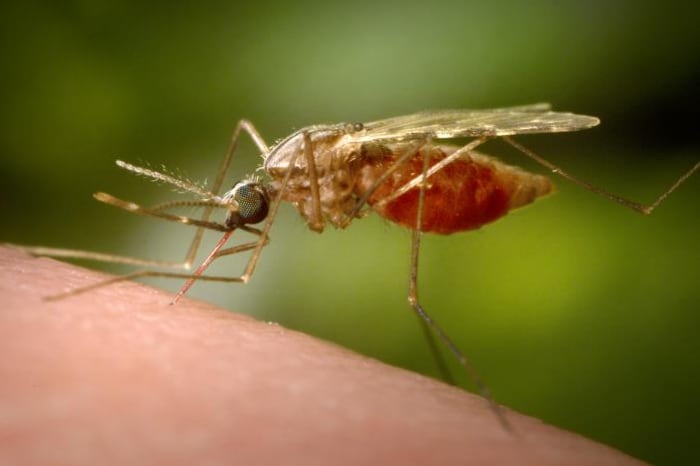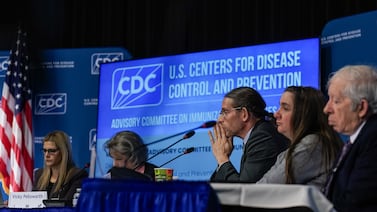Public health, explained: Sign up to receive Healthbeat’s free national newsletter here.
An unusual series of small U.S. malaria outbreaks – attributed to mosquito bites occurring in Florida, Maryland, Texas, and Arkansas in 2023 – illustrates what may be an increasing risk of the disease transmitting locally in the future, according to new research from local and federal public health investigators.
Their paper, published this month in the journal JAMA Network Open, comes as health officials in New Jersey and Washington state are investigating the potential that two people may have been infected with malaria this summer in those states. Neither had traveled to international destinations recently.
Malaria was largely eliminated in the United States more than 70 years ago and health officials say the risk of contracting the disease in this country remains low.
The greatest risk involves international travel to countries where the disease is widespread. Such travel is the source of most of the 2,000 malaria cases in the United States each year, according to the Centers for Disease Control and Prevention.
Yet the local U.S. malaria outbreaks in 2023 and sporadic locally transmitted cases over the decades illustrate the potential for malaria infections to occur from mosquito exposures across the United States.
That’s because when malaria-infected travelers return to or arrive in the United States and are bitten by local mosquitoes, the disease can spread in U.S. communities. More than a dozen states – including Georgia and New York – are where most of these imported malaria cases have been identified.
Here’s what you need to know.
What is malaria?
Malaria is a serious, but treatable, disease caused by a parasite that is transmitted by a specific type of mosquito, called the Anopheles. To spread the disease, mosquitoes must first bite a person who already has a malaria infection, then go on to bite other people. The disease does not spread from person to person like the cold or flu.
Initial symptoms – which typically occur seven to 30 days after infection – can include fever, chills, headache, muscle aches, and fatigue. If not quickly treated, the disease can become fatal, causing kidney failure, seizures, and coma, according to the CDC.
How often do malaria cases occur in the U.S.?
Local transmission of malaria in the United States was largely eliminated by 1951 because of intensive public health efforts dating back to 1914 that included drainage projects and the spraying of mosquito-killing pesticides.
The Centers for Disease Control and Prevention, which began in 1946 as the Communicable Disease Center, traces its history to an earlier World War II malaria-control agency that worked to protect troops at military training bases in Southern states as well as U.S. territories. The historic challenges eliminating malaria in the Southeast is a big part of why the CDC is based in Atlanta.

Malaria was considered eliminated from the United States by the early 1950s and the World Health Organization certified the United States as malaria-free in 1970.
These days, malaria cases in the United States are usually the result of infections that occurred during international travel. Each year there are about 2,000 travel-related malaria cases reported to the CDC, and on average during 2007-22 there were nearly seven deaths per year.
On occasion, however, the public health teams that investigate each U.S. malaria case cannot find any connection to international travel, raising the possibility that the infection occurred here in the United States.
For example, in August 2002, when two teenagers in northern Virginia became infected locally, public health investigators concluded the source of their infections was “probably the bite of an infective mosquito that had acquired the parasite by biting a malaria-infected person in the general vicinity.” The teens lived about a half mile apart from each other, but the 19-year-old who became infected had made numerous visits to friends who lived across the street from the 15-year-old who became infected.
How unusual were the domestic outbreaks of malaria in 2023?
Over the past 50 years, the CDC says that malaria that has been transmitted locally in the United States has resulted in more than 150 cases and more than 60 limited outbreaks.
Yet after 2003, no U.S.-acquired malaria infections from local mosquito bites were detected for 20 years. That ended in 2023, according to an examination of the 2023 cases by local, state and federal health officials published this month in JAMA Network Open.
From May through September 2023, 10 people across four states were sickened with fevers and other malaria symptoms, nine of them seeking treatment from emergency departments, and one from primary care.
After a 20-year absence of documented local malaria infections, it was “unexpected” to have so many cases spread across multiple states in one summer, the researchers wrote.
Seven of the people lived in Sarasota County, Florida, and the other three lived in Cameron County, Texas; Saline County, Ark; and the National Capital Region of Maryland. All were treated with antimalarial medications and recovered.
None had recent international travel that could explain their malaria exposures, the team found, and none had risk factors for blood-borne transmission, such as transfusions, tattoos, or needle-sharing practices.
The public health investigators found that in the weeks before these people became ill, all had a history of spending time outdoors at night – the time when Anopheles mosquitoes pose the greatest risk. Two of the infected people had worked outdoors overnight, three reported being homeless, and the rest said they had been involved in other types of outdoor nighttime activities.
Genetic and other testing determined that the cases in Florida, Arkansas, and Texas involved malaria strains associated with Central or South American parasites, the paper says. The Florida cases appeared to share a common source, the testing indicated.
But the Arkansas and Texas cases were not genetically related to each other nor were they related to the Florida cases. The infection in the Maryland case had a genetic signature consistent with African malaria parasites.
Hundreds of mosquitoes were collected and tested in the four states in the areas near where the infected patients lived. Three Anopheles mosquitoes captured over three nights in May 2023 from the same swamp in Sarasota County, Florida indicated a recent blood meal from a person infected with malaria. Evidence of malaria was not detected in any of the other mosquitoes collected as part of the investigation.
A spokesperson for the Florida Department of Health in Sarasota County said no one was available to discuss the 2023 cases.
What caused these outbreaks?
The research team noted that there were likely many factors that contributed to the U.S. malaria outbreaks in 2023. It’s suspected that the risk of local transmission of malaria has increased along with the increase in the number of malaria cases being imported to the United States through international travel.
After the Covid-19 pandemic, as “as international travel rebounded, preliminary 2023 data suggested a record high of 2,205 imported malaria cases,” the researchers said.
While most U.S. states report at least one travel-related case of malaria each year, 75% of these infected travelers in 2022 were located in 13 states. Three of the four states involved in the 2023 outbreaks were among the top states with imported cases of malaria.
Other top states for imported malaria cases in 2022 included Georgia, New York, Pennsylvania, Ohio, Virginia, Minnesota, and Virginia.
Prior to the 2023 locally acquired malaria cases, the new paper notes that the last outbreak of locally transmitted malaria occurred in 2003 in Palm Beach County, Florida, that involved eight cases.
What lessons can we take from the 2023 malaria outbreaks?
While the research team said sustained malaria transmission within the United States is unlikely, they warned that a variety of factors may increase the risk of future cases that are locally acquired in U.S. communities.
Those factors include continued increases in international travel and migration, and that rising temperatures increase the potential for mosquito exposures.
The researchers noted that there were several challenges to identifying these locally transmitted malaria outbreaks because doctors may not consider malaria as a possible diagnosis when people haven’t had recent international travel.
“Although all patients were eventually diagnosed and treated appropriately, several experienced delayed diagnosis and health care access barriers,” the paper notes.
In addition, they said, more research is needed about the prevalence and patterns of Anopheles mosquitoes in the United States. Other species are prioritized because they more commonly spread disease in this country.
“There is no national surveillance system for Anopheles species,” they wrote. And they noted that local capabilities to perform resource-intensive mosquito control efforts vary by jurisdiction.
“This case underscores common challenges in malaria diagnosis, including differentiation from babesiosis and other diseases, and potential for sporadic locally acquired malaria cases in the United States,” said Amanda Hils, a spokesperson for the Maryland Department of Health, whose investigators were co-authors of the paper. “It also highlights the need for coordinated efforts among public health officials, clinicians, laboratories, and the public to prevent, detect, investigate, and respond to such cases.”
What’s known so far about this summer’s New Jersey and Washington malaria cases?
In New Jersey, state health officials announced in August that they were working with the CDC to investigate a possible locally acquired malaria infection in a resident of Morris County, which is about 30 miles northwest of New York City.
The infected resident had no history of international travel, state health officials said. They noted the possibility the person became infected in New Jersey and said they were working to reduce potential public risks through local mosquito control activities.
If the New Jersey case is confirmed as being a locally acquired infection, it would be the first in the state since 1998, officials there said.
“The investigation to determine a potential source of the case is ongoing and is awaiting investigational testing at CDC,” Dalya Ewais, communications director for the New Jersey Department of Health, told Healthbeat on Thursday. “This testing takes time and may or may not provide definitive information.”
Ewais said the department’s trapping and testing of mosquitoes did not identify any that carried malaria parasites. The department also is not aware of any additional cases of suspected locally acquired malaria in the state, beyond the one in Morris County, she said.
“Risk of non-travel-related malaria to the general public in New Jersey remains low,” she said.
In Washington, the Tacoma-Pierce County Health Department announced earlier this summer that a woman in East Pierce County, who had not traveled recently, was diagnosed with malaria on Aug. 2.
The county health department, which has been working with the Washington State Department of Health and the CDC to investigate how the woman became infected, said it did not have an update to provide about the investigation at this time. The department as previously noted it’s “possible she was recently infected with malaria in Washington.”
If confirmed, the department said it would be the first known locally acquired case of malaria in Washington.
The CDC, which is part of the ongoing federal government shutdown, did not respond to a request for information about the New Jersey and Washington malaria cases.
What can U.S. residents do to reduce their risk of malaria?
Because mosquitoes can spread a variety of diseases besides malaria – including the viruses that cause West Nile virus, dengue and Zika – the CDC recommends protecting against mosquito bites. Some tips for doing this include using proven insect repellants that are registered with the U.S. Environmental Protection Agency, wearing loose-fitting clothing with long sleeves and pants, using screens on windows and doors, and eliminating or treating standing water outdoors where mosquitoes breed.
The biggest risk of being infected with malaria comes with international travel. Most of the approximately 2,000 cases of malaria diagnosed in the United States each year involve people returning home after trips to countries where malaria is common.
For U.S. cases where the country of infection was known in 2019, the CDC says 93% acquired malaria in Africa; 4% in Asia; 2% in the Caribbean, South America and Central America; and less than 1% in Oceania and the Middle East. When these infections occurred among U.S. civilians, 76% were traveling to visit friends or relatives.
Before going to countries where malaria is endemic, the CDC advises travelers to consult with health care providers about their risk factors and whether they should be taking an anti-malaria medication to prevent infection during their trip. The CDC maintains a list of health risks by international destination and guidance for health care providers who advise and treat travelers.
CDC officials note that even people who may have once had some immunity to malaria because they previously lived in a country where the disease is widespread can quickly lose that immunity. They are also urged to take preventative actions to avoid infection.
Preventing malaria infections during international travel reduces the risk of bringing the parasites back to the United States, where mosquito bites on returning home have the potential to spread the disease in this country.
Where in the world does malaria pose the greatest risk?
Worldwide there were an estimated 263 million malaria cases and 597,000 deaths in 83 countries during 2023, according to the WHO.
About two-thirds of these malaria cases and deaths occurred in 11 African countries: Burkina Faso, Cameroon, Democratic Republic of the Congo, Ghana, Mali, Mozambique, Niger, Nigeria, Sudan, United Republic of Tanzania and Uganda. And the African region as a whole accounted for an estimated 94% of malaria cases, according to the WHO.
But malaria endemic countries are found around the world. Outside of Africa they include Bolivia, Brazil, Colombia, Haiti, Indonesia, Iran, Myanmar, Pakistan, Panama, Papua New Guinea, and Peru.
The United States is among 44 countries and one territory that have been certified as malaria-free by the WHO.
Alison Young is Healthbeat’s senior national reporter. You can reach her at ayoung@healthbeat.org or through the messaging app Signal at alisonyoungreports.48






